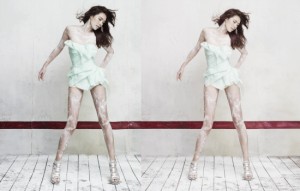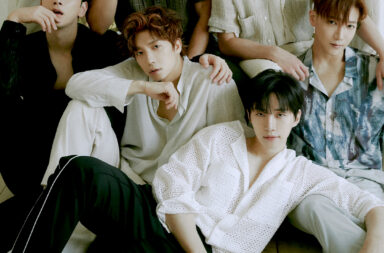After School recently released a new album; what caught my attention this time, however, was not the MV nor the song itself, but the fact that the teaser images were accompanied by a Pledis Entertainment statement saying:
We focused on group members’ beautiful legs through the teasers. Since all group members have perfect legs, we didn’t have to retouch the teasers.
Photoshop, in one way or another, seems to be a discussion point every time a promotional picture comes out. Traditionally, it’s the excessive use of it that makes the headlines; lately, however, there’s a new trend in the K-pop scene: the ‘no Photoshop’ images.
You may (or may not) remember the incident with Secret‘s Japanese promotional pics in which the girls’ legs were compared with an unphotoshopped picture of them in a really unflattering position. Same has been done with Shin Se-kyung and Shin Min-ah, for example, although anyone with a little bit of common sense can see that Photoshop in the Korean media tends to be excessive — excessive to a point where they show bodies physically unattainable.
A little background on the Photoshop phenomenon in Korea: while Photoshop is basically used everywhere and for every single ad, Korean advertising industry probably displays some of the most extreme cases, sometimes leading to unreal and almost virtual-like bodies. No wonder South Korea is the country that undergoes the most plastic surgery in the world (per population) — although I’m not really getting there, there’s probably a relationship between promoting unachievable stereotypes and such a high percentage of plastic surgery. Moreover, the use of Photoshop seems to be widely accepted and not really questioned, taking a look at what’s considered a moderate use of Photoshop (well yes, you can still recognize G.NA, but seriously, where are her knees?).
The ‘no Photoshop’ trend could have arised as alternative to these unreal bodies — yet that is not the intention. The excessive photoshopping and the ‘no Photoshop’ pics are, as I see it, two sides of the same coin.
The After School teaser images are not the only example; before that, Pledis had already used this technique with Kahi, Son Dambi and UEE in different photoshoots. Some of the SNSD and T-ara members have also seen pictures of them highlighted as a proof that they are pretty and well-proportioned even without Photoshop. For idols that are known by having perfect bodies, there is a special interest in showing non-photoshopped images to reassert that they look perfect by themselves.
What’s interesting, though, is that while some of the pics categorized as non-photoshopped are actually photoshoots that are afterwards retouched to feature as promotional images, while others, however, are just images taken by fans in the streets or even selcas. Putting them under the ‘no Photoshop’ group basically reinforces the idea that it is widely assumed all the idol images we see have been retouched to a degree that the idol may or may not look like that in real life.
So this trend basically represents the same as pointing out the excessive Photoshop. On one hand, it validates the use of Photoshop by not really repealing it; on the other hand, it reinforces the same stereotypes. As I see it, there is no attempt of critique towards the overuse of Photoshop in the media, just an acceptance that all images are retouched. So does the ‘no Photoshop’ trend bring something new to the table? Well, most probably not – just a new marketing strategy in the old ‘perfect legs’ topic. I still appreciate that they decide to keep Nana’s knees on a pic, though.
(The Grand Narrative [1] [2] [3], Pledis Entertainment, Buckaroo)




